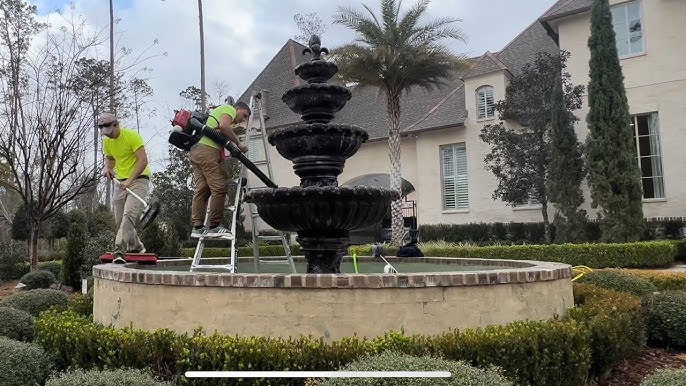
Decorative fountains and water features can transform an ordinary yard into a relaxing oasis. But as beautiful as they are, they can quickly become grimy eyesores if not properly maintained. Algae, mold, bird droppings, hard water stains, and mineral buildup are all common issues—and that’s where power washing can help 💦.
Used correctly, power washing can restore your fountain to its former beauty without damaging it. In this guide, we’ll explore how to clean fountains and water features the right way—safely, efficiently, and beautifully.
💧 Why Water Features Get So Dirty
Whether your fountain is made of stone, concrete, metal, or fiberglass, it’s constantly exposed to the elements. Some of the most common contaminants include:
- Algae and moss growth from standing water
- Mineral deposits from hard water or evaporation
- Dirt, dust, and leaves collecting in basins and crevices
- Bird droppings and insect nests from nearby wildlife
- Mold and mildew forming in shaded or humid spots
All of this buildup can degrade the aesthetic and functionality of your fountain or pond. It can even harm the water pump or attract mosquitoes 🦟.
⚠️ Can You Power Wash All Fountains?
Before grabbing your pressure washer, you need to ask: Is my fountain made from a material that can handle pressurized water?
Here’s a general rule of thumb:
| Material | Power Washing Safe? |
|---|---|
| Concrete | ✅ Yes, with caution |
| Natural stone | ✅ Yes, low pressure |
| Fiberglass/resin | ⚠️ Maybe – soft wash only |
| Metal (bronze, copper) | ❌ No – may discolor or dent |
| Painted or sealed finishes | ⚠️ Only with low pressure |
If your water feature is fragile or antique, consider hand-cleaning instead to avoid damage.
Browse Amazon Here For Top Rated Power Washers And Accessories
🧼 Step-by-Step: How to Power Wash a Fountain Safely
Here’s how to clean your fountain or water feature using a pressure washer the right way:
1. Turn Off Power and Remove Pump
Unplug any electrical components and carefully remove the water pump. Clean it separately with a soft brush to avoid clogging the impeller.
2. Drain the Fountain
Empty all water from the feature. If there’s a drain plug, use it. If not, you may need to scoop water manually or use a wet/dry vacuum.
3. Pre-Treat with a Cleaning Solution
Use a biodegradable, non-toxic cleaner that’s safe for outdoor use. Avoid bleach—it can damage surfaces and harm nearby plants. Let the cleaner dwell for 5–10 minutes.
4. Use a Low-Pressure Setting
Set your pressure washer to 1,200 PSI or less. Choose a 25- or 40-degree nozzle for broader coverage. Stand 2–3 feet away from the surface and avoid spraying directly into seams or cracks.
5. Work from Top to Bottom
Spray in smooth, overlapping motions. This helps prevent streaking and ensures even cleaning. Focus on areas with visible algae or stains, but don’t linger in one spot too long.
6. Rinse Thoroughly
After you’ve cleaned the surface, give the entire feature a rinse with plain water. Make sure to flush out crevices and drain holes to remove any lingering detergent.
7. Clean and Reinstall the Pump
Make sure the pump is clear of debris. Soak it in a vinegar solution if mineral buildup is present. Once clean and dry, reinstall it carefully.
8. Refill and Test
Fill your fountain with clean water and restore power. Check for leaks, and ensure the water flows properly.
🪴 Extra Tips for Long-Term Maintenance
Maintaining a beautiful fountain doesn’t stop after one cleaning. Here’s how to keep it fresh year-round:
- Add an algaecide: Safe water treatments can prevent algae without harming pets or plants
- Use distilled water: Reduces mineral buildup and white calcium stains
- Clean monthly: Quick wipe-downs every 4–6 weeks prevent major buildup
- Cover in winter: If you live in a freezing climate, drain and cover the fountain to prevent cracks
🧽 Alternatives to Pressure Washing
If your fountain is made from a delicate or painted material, power washing may not be the best option. Try these gentler alternatives:
- Soft wash systems with mild detergents
- Manual scrubbing with a long-handled brush
- Garden sprayer for pre-treatment and rinsing
- Steam cleaning (for interior use or antique pieces)
The key is to avoid chipping, fading, or damaging pumps and finishes.
Browse Amazon Here For Soft Washing Equipment And Accessories
👷 When to Hire a Professional
Large water features, ponds, or multi-tiered fountains may require pro help—especially if they involve:
- Intricate stonework
- Lighting or electrical components
- Hard-to-reach corners or multiple levels
- Algae infestations or heavy buildup
A trained technician knows how to clean thoroughly while preserving the structure, finish, and functionality of the feature.
💡 Bonus Tip: Add a Splash of Essential Oil
Want to enhance your fountain experience? Add a few drops of lavender or eucalyptus essential oil to the basin after cleaning. These oils repel bugs and add a relaxing aroma 🌿💧.
✅ Final Thoughts: Clean, Clear, and Flowing
Power washing is a fantastic way to restore fountains and water features—as long as you treat them with care. Stick to low pressure, choose the right cleaner, and follow safe techniques to keep your water features flowing and sparkling all season long ✨⛲.
Browse Amazon Here For Top Rated Power Washers And Accessories



